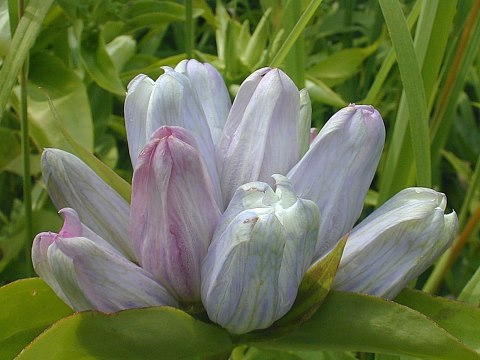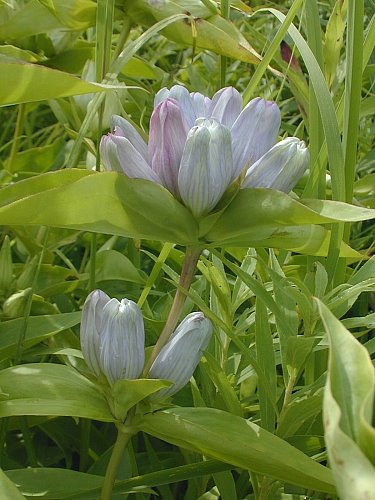
The central stem terminates in a sessile cluster of several flowers that is located directly above the uppermost pair of leaves. There is often another sessile cluster of flowers that is located directly above the second uppermost pair of leaves. This second cluster of flowers, when it is present, is usually smaller than the uppermost cluster of flowers. Individual flowers are 1¼-1½" long, consisting of a stout tubular corolla that is pale blue-violet to blue-violet, a short greenish calyx with 5 lobes, 5 inserted stamens, and an inserted pistil. The corolla has 5 inconspicuous lobes that are joined together by membranous tissue; the tips of the corolla lobes extend a little above the upper surface of the membranous tissue. The apex of the corolla is usually closed or only slightly open, causing the reproductive organs to remain hidden from view. The calyx lobes are lanceolate-ovate and about ¼" in length. Underneath the calyx of each flower, there is a pair of leafy bracts of highly variable size (¼-2" in length). These bracts resemble the leaves, except they are smaller in size. The blooming period occurs from late summer to early fall, lasting about 1 month. Afterwards, the flowers are replaced by one-celled seed capsules that are lanceoloid-ellipsoid in shape. Each seed capsule contains numerous small seeds. Individual seeds are oblongoid, somewhat flattened, and winged along their margins. The root system consists of a taproot.
Cultivation: The preference is full or partial sun, moist conditions, and soil containing loam or sand. This wildflower is rarely bothered by insects or disease organisms.

Range & Habitat: So far, the native Hybrid Bottle Gentian has been found only in Champaign County, Illinois (see Distribution Map), and it is quite rare within the state. This naturally occurring hybrid has also been reported from Wisconsin, Missouri, and a few other states, where it is also rare. Habitats include riverbottom prairies, restored prairies, woodland borders, low areas along water, and edges of marshes. Hybrid Bottle Gentian can occur where the ranges of its two parents, Gentiana andrewsii (Bottle Gentian) and Gentiana alba (White Gentian), overlap. It can also occur spontaneously in restored prairies wherever Bottle Gentian and White Gentian have been introduced together.
Faunal Associations: Bumblebees occasionally force their way into the flowers to obtain the nectar. Even though the foliage of this gentian is bitter-tasting, White-Tailed Deer sometimes chomp off the upper half of individual plants. Overall, the value of this and other gentians (Gentiana spp.) to wildlife is low.
Photographic Location: A restored prairie at Meadowbrook Park in Urbana, Illinois.

Comments: Hybrid Bottle Gentian can be variable in appearance, sometimes resembling Gentiana andrewsii (Bottle Gentian) to a greater extent than Gentiana alba (White Gentian), and sometimes resembling the latter to a greater extent than the former. These genetic variations may be the result of the relative abundance of one parent species as compared to the other in the area where this hybrid gentian occurs, thereby influencing overall gene flow. When Hybrid Bottle Gentian more closely resembles Bottle Gentian than White Gentian, it can be difficult to distinguish from another species, Gentiana saponaria (Soapwort Gentian), which also occurs in Illinois. Generally, Hybrid Bottle Gentian has calyx lobes that are more wide than those of Soapwort Gentian, even though their flowers and leaves may closely resemble each other. Other common names of Gentiana × pallidocyanea include Hybrid Closed Gentian and Pale Blue Gentian.